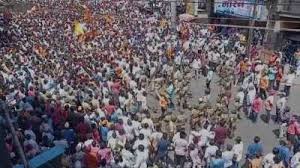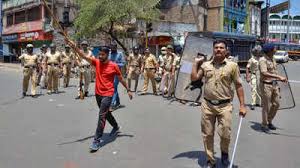Discover the clash in Kolhapur sparked by objectionable social media posts. Explore the suspension of internet services and political fallout.
In a digital age where social media plays a significant role in shaping public opinion, the power of a single post can have far-reaching consequences. Such was the case in Kolhapur, Maharashtra, where tensions flared due to objectionable social media posts regarding historical figures Aurangzeb and Tipu Sultan. The clash that followed serves as a reminder of the delicate balance between freedom of expression and its potential to incite violence. This blog explores the events that unfolded in Kolhapur, the subsequent suspension of internet services, and the political ramifications that emerged.
All in one trendz: Discover the national and international news
The Kolhapur Clash: Unearthing the Triggers

On the 7th of June, a small number of individuals in Kolhapur posted objectionable social media content referencing Aurangzeb and Tipu Sultan. The content quickly gained attention and drew criticism from various quarters. Right-wing activists staged protests against the alleged use of Tipu Sultan’s image and an objectionable audio message in social media “status” posts. As tensions escalated, clashes between protesters and the police erupted on the streets, leading to stone-pelting and acts of violence.
The Suspension of Internet Services
In response to the escalating violence, the local administration made the decision to partially suspend internet services in Kolhapur. This move aimed to control the spread of provocative content and prevent further incitement. Internet services were restored after a two-day suspension, gradually allowing the city to return to a semblance of normalcy.
Political Fallout and Reaction
The clash in Kolhapur quickly became politicized, with different parties exchanging allegations and capitalizing on the incident for their own gain. Nationalist Congress Party (NCP) President Sharad Pawar accused the ruling Bharatiya Janata Party (BJP) of giving religious color to minor issues and creating a rift between communities. He urged the government to focus on maintaining law and order rather than exacerbating religious tensions.
In response, Maharashtra Deputy Chief Minister Devendra Fadnavis emphasized the need to uphold the legacy of Chhatrapati Shivaji Maharaj, a revered historical figure in Maharashtra, and condemned any glorification of Aurangzeb. He called for an investigation into the coordinated response from certain leaders and questioned their motives.
Restoring Peace and Normalcy
Efforts to restore peace and harmony in Kolhapur involved a multi-faceted approach. District guardian minister Deepak Kesarkar convened a peace committee comprising members from various organizations and communities. The committee pledged to maintain peace in the city and prevent further violence. Additionally, the administration established independent committees to ensure peaceful celebrations of festivals and prevent communal discord.
The clash in Kolhapur serves as a reminder of the potential consequences of irresponsible social media use and the importance of maintaining peace and harmony in a diverse society. The suspension of internet services, though a temporary measure, highlights the challenges authorities face in balancing freedom of expression with the need to prevent violence. As the city gradually recovers from the turmoil, it is crucial for all stakeholders to engage in dialogue, promote understanding, and work towards a more inclusive and tolerant society.

In a digital age where social media plays a significant role in shaping public opinion, the power of a single post can have far-reaching consequences. Such was the case in Kolhapur, Maharashtra, where tensions flared due to objectionable social media posts regarding historical figures Aurangzeb and Tipu Sultan. The clash that followed serves as a reminder of the delicate balance between freedom of expression and its potential to incite violence. This blog explores the events that unfolded in Kolhapur, the subsequent suspension of internet services, and the political ramifications that emerged.
The Kolhapur Clash: Unearthing the Triggers
On the 7th of June, a small number of individuals in Kolhapur posted objectionable social media content referencing Aurangzeb and Tipu Sultan. The content quickly gained attention and drew criticism from various quarters. Right-wing activists staged protests against the alleged use of Tipu Sultan’s image and an objectionable audio message in social media “status” posts. As tensions escalated, clashes between protesters and the police erupted on the streets, leading to stone-pelting and acts of violence.
The Suspension of Internet Services
In response to the escalating violence, the local administration made the decision to partially suspend internet services in Kolhapur. This move aimed to control the spread of provocative content and prevent further incitement. Internet services were restored after a two-day suspension, gradually allowing the city to return to a semblance of normalcy.
Political Fallout and Reaction
The clash in Kolhapur quickly became politicized, with different parties exchanging allegations and capitalizing on the incident for their own gain. Nationalist Congress Party (NCP) President Sharad Pawar accused the ruling Bharatiya Janata Party (BJP) of giving religious color to minor issues and creating a rift between communities. He urged the government to focus on maintaining law and order rather than exacerbating religious tensions.
In response, Maharashtra Deputy Chief Minister Devendra Fadnavis emphasized the need to uphold the legacy of Chhatrapati Shivaji Maharaj, a revered historical figure in Maharashtra, and condemned any glorification of Aurangzeb. He called for an investigation into the coordinated response from certain leaders and questioned their motives.
Restoring Peace and Normalcy
Efforts to restore peace and harmony in Kolhapur involved a multi-faceted approach. District guardian minister Deepak Kesarkar convened a peace committee comprising members from various organizations and communities. The committee pledged to maintain peace in the city and prevent further violence. Additionally, the administration established independent committees to ensure peaceful celebrations of festivals and prevent communal discord.
In a digital age where social media plays a significant role in shaping public opinion, the power of a single post can have far-reaching consequences. Such was the case in Kolhapur, Maharashtra, where tensions flared due to objectionable social media posts regarding historical figures Aurangzeb and Tipu Sultan. The clash that followed serves as a reminder of the delicate balance between freedom of expression and its potential to incite violence. This blog explores the events that unfolded in Kolhapur, the subsequent suspension of internet services, and the political ramifications that emerged.
The Kolhapur Clash: Unearthing the Triggers
On the 7th of June, a small number of individuals in Kolhapur posted objectionable social media content referencing Aurangzeb and Tipu Sultan. The content quickly gained attention and drew criticism from various quarters. Right-wing activists staged protests against the alleged use of Tipu Sultan’s image and an objectionable audio message in social media “status” posts. As tensions escalated, clashes between protesters and the police erupted on the streets, leading to stone-pelting and acts of violence.
The Suspension of Internet Services
In response to the escalating violence, the local administration made the decision to partially suspend internet services in Kolhapur. This move aimed to control the spread of provocative content and prevent further incitement. Internet services were restored after a two-day suspension, gradually allowing the city to return to a semblance of normalcy.
Political Fallout and Reaction
The clash in Kolhapur quickly became politicized, with different parties exchanging allegations and capitalizing on the incident for their own gain. Nationalist Congress Party (NCP) President Sharad Pawar accused the ruling Bharatiya Janata Party (BJP) of giving religious color to minor issues and creating a rift between communities. He urged the government to focus on maintaining law and order rather than exacerbating religious tensions.
In response, Maharashtra Deputy Chief Minister Devendra Fadnavis emphasized the need to uphold the legacy of Chhatrapati Shivaji Maharaj, a revered historical figure in Maharashtra, and condemned any glorification of Aurangzeb. He called for an investigation into the coordinated response from certain leaders and questioned their motives.
Restoring Peace and Normalcy
Efforts to restore peace and harmony in Kolhapur involved a multi-faceted approach. District guardian minister Deepak Kesarkar convened a peace committee comprising members from various organizations and communities. The committee pledged to maintain peace in the city and prevent further violence. Additionally, the administration established independent committees to ensure peaceful celebrations of festivals and prevent communal discord.
The clash in Kolhapur serves as a reminder of the potential consequences of irresponsible social media use and the importance of maintaining peace and harmony in a diverse society. The suspension of internet services, though a temporary measure, highlights the challenges authorities face in balancing freedom of expression with the need to prevent violence. As the city gradually recovers from the turmoil, it is crucial for all stakeholders to engage in dialogue, promote understanding, and work towards a more inclusive and tolerant society.
For more news:-All in one trendz: Discover the national and international news


